
THE OLD TOWN IN PRAGUE AND ITS HISTORY
Actually Prague should be called "the treshhold city" as a nickname, because the Czech word Praha is derived from "prah", meaning treshhold. The legend tells, that the mother of the House of Přemysl, Libuše, predicted that name to the city, which she even founded.
How much truth there is in that legend, cannot be determined any more, because the first historically proven souvereign of Bohemia was Boňvoi I Přemysl. On the other hand he had been Duke of Bohemia as early as in the middle of the 9th century. After that the Přemysls reigned until the beginning of the 14th century.
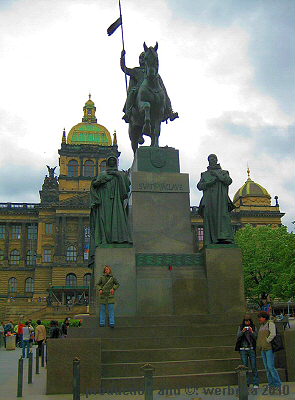 |
The last five of them were no longer dukes, but already Kings of Bohemia. The name of Bohemia is, by the way, derived from a tribe of the Celts, the Boier, who had settled in this area even before the Slaves came.
At the edge of the Old Town, at the metrostation Muzeum, the Wenceslas Square starts, named in honour of Saint Wenceslas, the national saint of the Czech. He is sitting high on a horse, at the highest part of that 700 meter long street, in front of an impressing building (part of the National Museum), which gives the "Square" an illustrious appearance.
This Saint Wenceslas was Duke of Bohemia between 921 and 928 or even 935. The day of his death, Sept. 28th, today is a national holiday. But it would take another 300 years, before King Wenceslas I fortified the area of the Old Town with city walls and gave town privileges to it. At that time, the town still was called Mezihrady (=between castles), because it was situated between the two castles of Pražký hrad and Vyšehrad. |
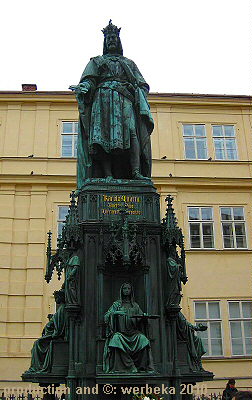 |
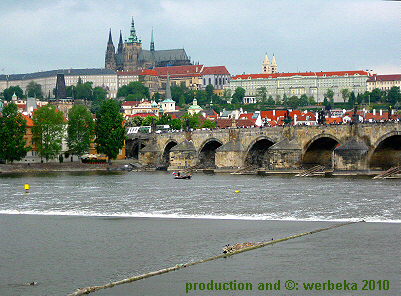 |
| King Charles I of Bohemia finally became Holy Roman Emperor of the German Nation and as such got the ordinal number IV. Certainly enough an Emperor has to have a residence fitting his title, that is why Charles IV still is remembered as renovator of the city and as "father of the nation". |
He founded the St. Vitus Cathedral within the Castle of Prague, he had the Charles Bridge built (both on the upper image to the right), founded the New Town and expanded the fortification walls.
Before that (1344) he had accomplished to make Prague an archbishopric and in 1348 he founded the first university in the heart of Europe (teaching language was German, though).
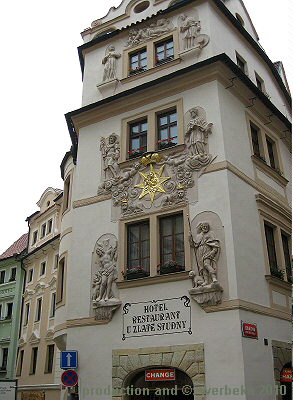 |
In the second half of the 14th century Prague probably experienced its greatest hight in history. At that time it was after Paris, Ghent and Bruges the forth biggest city north of the Alps. But family discourses and the Hussite Wars threw Prague quickly back and down from the top of its development.
First when the Habsburgs (who, of course also were Roman Emperors of the German Nation) acquired the title of Kings of Bohemia through marriage, and Rudolf II moved his residence to Prague, the town won some prestige again. Rudolf didn't have any great talent for politics, but he was a devoted art lover. This is why the Late Renaissance in Prague bloomed during his reign and the art collections grew in importance. A hundred years later the Thirty Years War was to follow, and then those collections were plundered to a large extent by both sides.
During Habsburg-reign even the Baroque was a favoured architectural style and still today there are many palaces from these two periods to be seen.
|
A hundred years after the Thirty Years War the attacks on Austria by the Prussian King Frederick II were to come, and Prague again was situated in the middle of the turmoil.
The blackmailing and treacherous Frederick succeeded in 1757 to besiege the four towns of Prague, in order to starve them out - which in the end was not successful. The people of Prague stood steadily behind Maria Theresa of Austria.
First in 1784 the four parts of Prague - the Old Town, the Hradčany, the Malá Strana (Lesser Town) and the New Town - joined together to build a new entity. In the 19th century, caused by industrialization, there was a lot of immigration into the city, from the rural surroundings. This were mainly Slaves, so that in 1855 the German speaking population in Prague lost the majority - for the first time since the Middle Ages.
On the other hand the new national consciousness contributed to a boost of Czech art, which clearly can be seen, when looking at the number of active composers, painters, writers, etc. Kafka, Rilke, Werfel, Havránek, Šimek, Smetana, Dvořák - just to mention the most outstanding names.
But even the German speaking part was not forgotten in the 19th century. The Rudolfinum at the banks of the Vltava was built in the years 1876 - 1884 by Josef Zitek and his pupil Josef Schulz.
The patronage was mainly given by Rudolf von Habsburg, the son of Emperor Francis Joseph and Elisabeth; but at the same time even "Prague's Habsburg", Emperor Rudolf II, was honoured.
Today the Czech Philharmonic Orchestra finds its home here in the many concerthalls within - but there is also an art gallery, which generally shows contemporary art. Between the two World Wars and in 1945-1946 this was the seat of the Czechoslovakian parliament. |
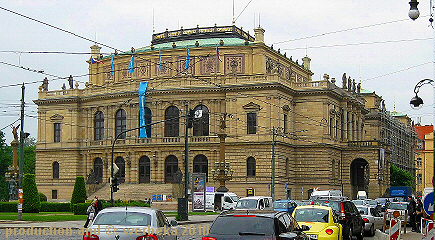 |
Even if the Czech nationalism before and in WWI is understandable, which finally led to the construction of the state of Czechoslovakia, the ethnic cleansing immediately after WWII can not be excused. In only twelve days 27,000 German speaking civilians became victims of this hysteria. Another 2.5 million were thrown out of the country.
After 45 years of communist governance, Prague finally became the capital of the Czech Republic on January 1st, 1993. Despite all nationalism the Czech were very eager to become a member of the European Union, which by far exceeds the multinational construction of Austria-Hungary from a hundred years ago.
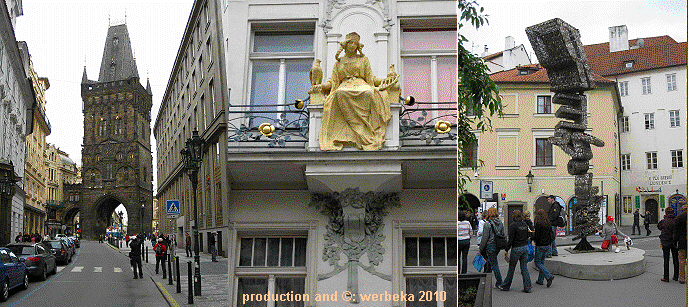
Within only a few minutes of walking distance coming from the old, gothic Powder Gate, passing houses with ornaments in Art Nouveau, one suddenly stands in front of a modern creation (made of keys!), which, read from above, spells the word "revoluce" (revolution).
The Old Town's main charm consists probably of buildings from different ages standing side-by-side and a "laid-back"-attitude of the population, which hasn't become part of the Western world's stress, as so many other big cities in our time.
In any case you should take your time to stroll leisurely through the Old Town, in order to enjoy the atmosphere. And you shouldn't forget to lift your gaze from time to time, just for getting yet another surprise. Furthermore - behind quite some Baroque facade there are still Gothic walls hidden, which again rest on Romanic fundaments. ...
Copyright Bernhard Kauntz, Wolvertem 2010
Back to  or to the or to the  of of 
last update: 30.5.2010 by webmaster@werbeka.com
|








